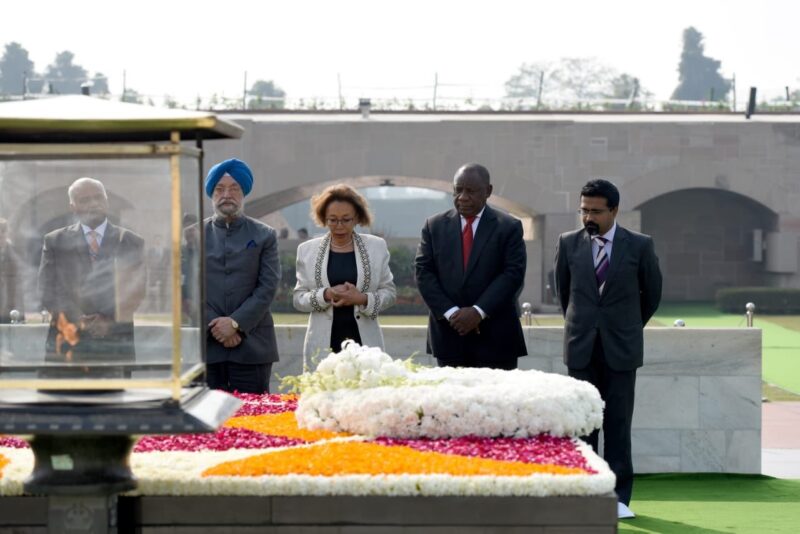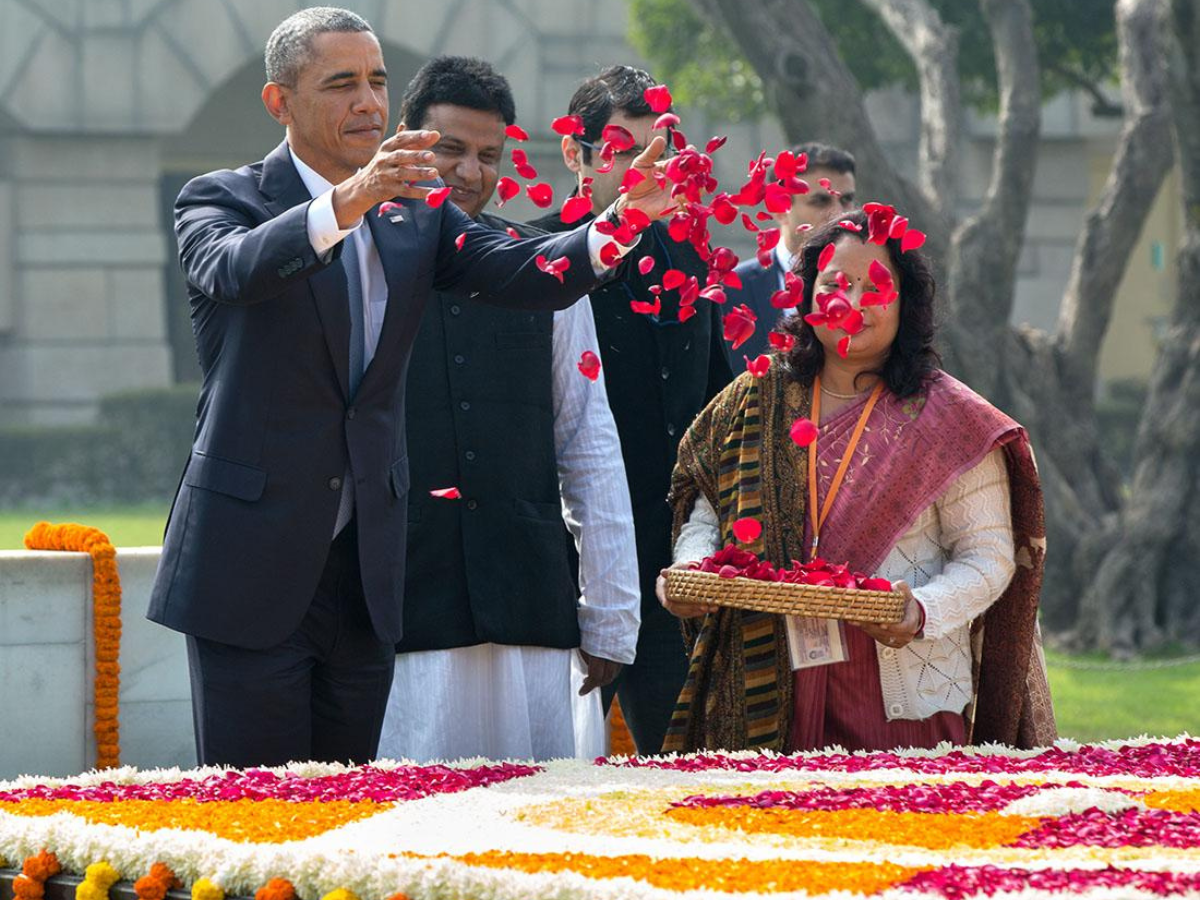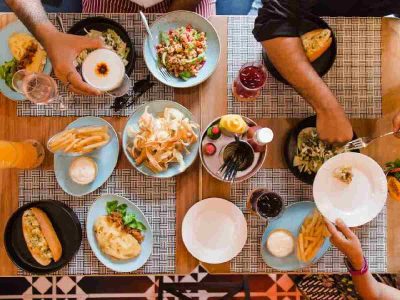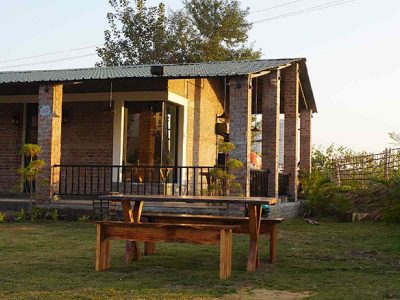After paying floral tributes at the Samadhi of Mahatma Gandhi at Rajghat, US president Joe Biden would be presented with My Experiments with Truth, the autobiography of Bapu, along with other Gandhian literature as well as a book on Rajghat.
And when he would be flipping through the pages of the book on Rajghat in his car, Biden will mostly likely read about the visit of civil rights champion Martin Luther King Jr and his wife Coretta Scott King to Rajghat in 1959.
King Jr was in tears at Rajghat on February 11, 1959. It was a moment of truth for him as Gandhiji was his idol. King told the waiting press there, “To other countries, I may go as a tourist but to India I come as a pilgrim… if this age is to survive, it must follow the way of love and non-violence that [Gandhi] so nobly illustrated in his life.”
Since then, hundreds of world leaders have visited Rajghat. Now, the heads of states of G20 nations would visit Rajghat during their stay in the Capital.
Some are likely to visit Gandhi Smriti (earlier Birla House) where Bapu fell to senseless bullets of merchant of death and hatred, Nathuram Godse.
Surely, Biden would smile when he would know that Rajghat was designed by Vanu G. Bhuta, an American-trained Indian architect who won the Government-sponsored competition to create a suitable memorial for Gandhi in 1956. He designed it in a way to reflect the profound austerity of Gandhi’s life.
Though Russian President Vladimir Putin is not attending the G20 summit due to domestic reasons, he came here on October 3, 2000.
He wrote in the visitors’ book at Rajghat, “We are paying venerable homage to the genius of Mahatma Gandhi, the father of an independent and prosperous India.”
Putin, accompanied by wife Ludmila and members of his delegation, spent five minutes more than the scheduled 20 minutes during his visit. Putin and his wife planted a sapling of Him Champa (magnolia grandiflora) at the lawns of the samadhi. The sapling was planted in the same row of trees planted by Biden’s predecessor Bill Clinton and the then Chinese President Jiang Zamin.
Clinton had also planted a Him Champa.
“This is not my last visit. I will come again,” Putin said, when the samadhi staff requested him to return to see the tree planted by him.
Obama’s visit
Another US President Barack Obama, who considers Gandhi as one of the biggest influences on his life, paid his respects to Bapu at Rajghat on January 25, 2015.
In the visitors’ book, Obama wrote, “What Dr Martin Luther King Jr said then remains true today. The spirit of Gandhi is very much alive in India today. And it remains a great gift to the world. May we always live in the spirit of love and peace — among all people and nations.”
Obama also planted a sapling of the Peepal tree. Obama had mentioned Gandhi on many occasions, even during his Nobel Peace Prize acceptance speech in 2009.
On his second visit here in 2010, Obama wrote, “It’s a great honour and privilege to visit the memorial of Mahatma Gandhi, who was a great person, [and] who inspired the whole mankind with peaceful means.”
President of Brazil, Lula da Silva, with whom Prime Minister Narendra Modi has developed a very close friendship, visited Rajghat on June 4, 2007.
He was also presented with a replica of Gandhi’s famous charkha by the officials of the memorial. If Lula da Silva visits Rajghat again this time, it would be his second visit.
Recalls Rajneesh Kumar, the caretaker of Rajghat, “Brazilian president Lula spent more than 15 minutes at the Samadhi. After paying his tributes, he talked to the Rajghat staff to know more about Bapu.”
President of South Africa, Cyril Ramaphosa would also hopefully visit Rajghat again. He came for the first time in 2019. Of course, he would be thinking how a lawyer from India came to his country over 125 years ago, fought for the rights of under-privileged, became apostle of peace and inspired the likes of Nelson Mandela and Desmond Tutu, the tireless champions of anti-apartheid struggle.

Old timers of Delhi would recall that when Mandela came to Delhi in 1990 after his release from a long jail term, he visited Gandhi Smriti and stood for couple of minutes at the martyrs’ column.
National Gallery of Modern Art
Despite their very busy schedule in the Capital, some G20 leaders are also likely to visit the National Gallery of Modern Art at Jaipur House.
G20 leader and Chancellor of Germany, Olaf Scholz would be glad to know that Hermann Goetz (1898–1976), a noted German art historian, became its first curator and in time, added new facilities such as art restoration services, an art reference library and a documentation centre.
Of course, G20 leaders would be transported to another world on seeing an exhibition of contemporary sculpture and paintings by Amrita Sher-Gil, Rabindranath Tagore, Jamini Roy, Nandalal Bose and MAR Chugtai, among others.
The National Gallery of Modern Art is housed near India Gate in a butterfly-shaped building with a central dome. It was built in 1936, and designed by British architect Sir Arthur Blomfield following the construction of Lutyens’ Delhi.
Though the idea of a National Gallery was floated in 1949, it was formally inaugurated by vice-president S Radhakrishnan in 1954 in the presence of Prime Minister Jawaharlal Nehru.
Sadly, the German leader will not be able to see Gandhiji’s most iconic symbol in the Capital as his convoy would not cross from ITO. If he would come near the old Delhi Police headquarters, he would see the 150-ft long breathtaking mural of Gandhiji. The mural is the handwork of German graffiti artist Hendrick Beikirch and Indian painter Anpu Varkey.
Meanwhile, after coming out of the National Gallery, British Prime Minister Rishi Sunak and his French counterpart Emmanuel Macron would be definitely see India Gate and identify with it for different reasons.
“India Gate is one of the most important symbols of Raj days in India. It commemorates the 70,000 Indian soldiers who lost their lives fighting for the British Army during World War I. Designed by Edwin Lutyens, it bears the names of soldiers killed in the North-West Frontier in the Afghan War of 1919,” says historian Harish Chandra.
Macron would also love to have a closer look of it. It looks like a replica of Paris’s most iconic symbol, Arc de Triomphe.
The Arc de Triomphe honours those who fought and died for France in the French Revolutionary and Napoleonic Wars, with the names of all French victories and generals inscribed on its inner and outer surfaces.
Witnessing Indian agricultural prowess
There are indications that some of the top leaders of G20 would visit the campus of Indian Agricultural Research Institute, also known as Pusa Institute, to see how India is making rapid progress in agricultural research.
If Biden and Andrés Manuel López Obrador, the President of Mexico, too visit there, they would certainly see the statue of Norman E Borlaug, the American agricultural scientist who was regarded as the father of Green Revolution in India and Mexico.
“While working at Pusa, Borlaug developed semi-dwarf, disease-resistant wheat varieties and led the introduction of these high-yielding varieties combined with modern agricultural production techniques. As a result, wheat yields nearly doubled in India and Mexico, greatly improving food security in both the nations,” says PL Sharma, who was working for Pusa when Borlaug was working there.
The Borlaug statue holds a book inscribed with the names of some of the leading visionaries who worked with him during the “Green Revolution” – MS Swaminathan, C Subramaniam, B Sivaraman, AB Joshi, SP Kohli, Glenn Anderson, MV Rao and VS Mathur. It also contains a list in Latin and Hindi script of the original Mexican wheat varieties that were so productive in India.
The G20 leaders may also meet the foreign students doing research in agriculture at the Pusa campus. It is possible that South African President would talk to some students from Africa there.
Not many people know that legendary Argentina-born revolutionary Che Guvera had visited the Pusa Institute when he came to Delhi in 1958. This information should be shared with the President Mauricio Macri of Argentina, who was president of G20 in 2017.





